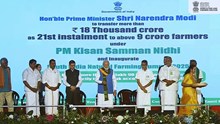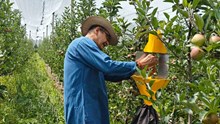
The Central Government has now made Vertical Farming eligible for financial assistance under the Agriculture Infrastructure Fund (AIF). Individual farmers and agripreneurs can avail loans of up to Rs 2 crore with a 3% interest subvention for setting up vertical farming systems. This initiative is part of the government’s larger push towards sustainable and modern agriculture. The move is expected to benefit farmers looking to adopt cutting-edge techniques such as hydroponics, aeroponics, and greenhouse farming.
What Is Vertical Farming?
Vertical farming is a method of growing crops in vertically stacked layers or structures, often inside climate-controlled buildings or containers. This technique uses significantly less land and water than traditional farming, making it ideal for urban areas or regions with limited agricultural space. It also allows for year-round cultivation, regardless of weather conditions, and often uses hydroponics or aeroponics instead of soil.
This technology-driven approach increases productivity and efficiency, reduces pesticide usage, and brings fresh produce closer to consumers, especially in cities.
Understanding the Agriculture Infrastructure Fund (AIF)
Launched in 2020, the AIF is a central sector scheme aimed at providing medium to long-term debt financing for investments in post-harvest management infrastructure and community farming assets. The fund seeks to enhance agricultural productivity, reduce post-harvest losses, and improve farmers' income by facilitating the development of modern agricultural infrastructure.
Eligibility Criteria for AIF Support
A diverse range of entities involved in agriculture and allied activities are eligible to apply for financial assistance under the AIF. These include:
-
Farmers: Individual cultivators seeking to invest in infrastructure to boost productivity.
-
Farmer Producer Organizations (FPOs): Collectives of farmers aiming to develop shared infrastructure.
-
Self Help Groups (SHGs): Community groups engaged in agricultural activities.
-
Agri-Entrepreneurs and Startups: Innovators introducing new technologies and methods in agriculture.
-
Primary Agricultural Credit Societies (PACS): Cooperative societies providing credit and other services to farmers.
-
Marketing and Multipurpose Cooperative Societies: Organizations involved in the marketing and distribution of agricultural produce.
-
Joint Liability Groups (JLGs): Groups of individuals jointly responsible for loan repayments.
-
Agricultural Produce Market Committees (APMCs): Bodies regulating agricultural markets.
These entities can leverage the AIF to establish various infrastructure projects, including vertical farming units.
Benefits of Availing AIF Support for Vertical Farming
Engaging with the AIF for vertical farming projects offers several advantages:
-
Interest Subvention: Eligible projects can receive an interest subvention of 3% per annum on loans up to Rs 2 crore for a maximum period of seven years, reducing the financial burden on borrowers.
-
Credit Guarantee: Loans up to Rs 2 crore are eligible for credit guarantee coverage under the Credit Guarantee Fund Trust for Micro and Small Enterprises (CGTMSE), with fees reimbursed by the government, enhancing credit accessibility.
-
Enhanced Productivity: Financial support facilitates the adoption of advanced vertical farming techniques, leading to increased crop yields and resource efficiency.
-
Sustainability: Vertical farming promotes sustainable agriculture by minimizing land use, reducing water consumption, and decreasing dependency on chemical inputs.
Steps to Apply for AIF Support for Vertical Farming
To access financial assistance for vertical farming under the AIF, applicants should follow these steps:
-
Project Conceptualization: Develop a detailed project report outlining the vertical farming initiative, including objectives, design, expected outcomes, and financial projections.
-
Identify a Lending Institution: Choose a suitable lending institution participating in the AIF scheme, such as scheduled commercial banks, cooperative banks, or regional rural banks.
-
Loan Application Submission: Present the project report and loan application to the selected bank for assessment.
-
Application on AIF Portal: Register and submit the application through the official AIF portal, providing all necessary project and personal details.
-
Approval and Sanction: The lending institution, in coordination with the Ministry of Agriculture's Project Management Units (PMUs), will evaluate the project. Upon approval, the loan will be sanctioned.
-
Implementation and Monitoring: After receiving funds, commence the establishment of the vertical farming unit. The project will be subject to periodic monitoring to ensure compliance with the proposed plan.
The inclusion of vertical farming in the Agriculture Infrastructure Fund (AIF) promotes the modernization of agriculture and supports sustainable practices. By offering financial assistance, the AIF enables farmers, entrepreneurs, and cooperatives to adopt innovative farming methods. This not only enhances productivity but also helps ensure food security.
Applicants are encouraged to thoroughly understand the eligibility criteria and application process to effectively leverage the benefits offered by the AIF for their vertical farming venture.
For more information about the scheme, please visit the AIF Portal.
-
What kind of financial support is available for vertical farming under AIF?
Farmers and agripreneurs can get loans up to Rs 2 crore with a 3% interest subvention for seven years. Credit guarantee coverage is also available to make funding more accessible.
-
Who can apply for AIF assistance for vertical farming?
Eligible applicants include farmers, FPOs, SHGs, startups, PACS, cooperatives, JLGs, and APMCs. Anyone involved in agriculture or allied activities can benefit from this scheme.
-
What farming methods are covered under vertical farming?
The scheme supports modern techniques like hydroponics, aeroponics, and greenhouse farming. These methods save space, reduce water use, and allow year-round cultivation.
-
How does one apply for AIF funding for vertical farming?
Applicants must prepare a detailed project report, approach a lending bank, and apply on the AIF portal. Once approved, funds are disbursed and the project is monitored.
-
What are the main benefits of AIF-supported vertical farming?
It offers low-interest loans, better credit access, and improved productivity. Plus, it promotes sustainable farming with less land, water, and chemical use.
















